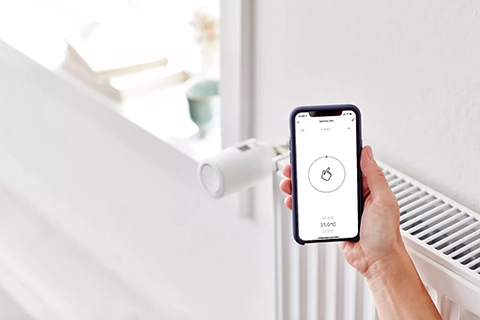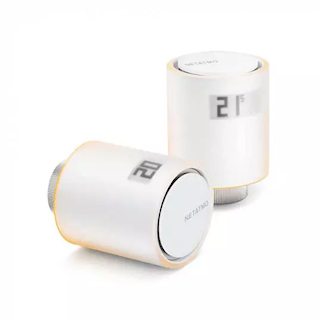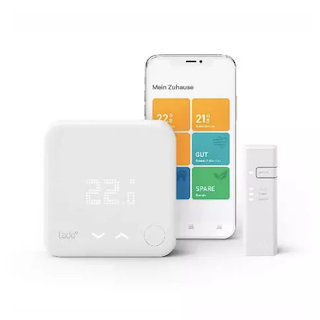Smart heating
Optimizing Heating with Smart Thermostats
When building or renovating, you have the choice between numerous energy-efficient heating systems. The energy consumption is significantly lower than with older systems, and often at least part of the energy is obtained from renewable energy sources. This protects the climate and your wallet. You can also optimize your heating system in existing properties without having to replace the entire system. Around 70% of the total energy consumption in the household is caused by heating. A closer look is worth it; even small changes can make a big difference. Smart heating thermostats are easy to install and promise significant savings. These are now available for almost all heating systems, including underfloor heating.
How do radiator thermostats work?

A radiator thermostat regulates the hot water supply to the radiators. On conventional thermostat heads, the desired temperature is set, usually in the form of stages from 1-5. With commercial thermostats, level 1 corresponds to a room temperature of around 12 degrees Celsius. Each additional stage means 3-4 degrees more. At level 5, the radiator heats the room to about 25 degrees. If the room is warmer than set on the thermostat, a pin on the valve base is pressed in and the opening of the valve is limited or completely closed. As a result, less or no hot water flows into the radiator. Consequently, the room temperature decreases over time. If it finally gets colder in the room than desired, the valve is opened. Heating water flows into the radiator and the room is warmed up.
How do smart thermostats differ?
Smart thermostats work on the same principle. The difference: They no longer have to be operated manually and can therefore regulate the temperature more easily, comfortably and energy-efficiently. If you want the bathroom to be warm for showering in the morning, but cool during the day because no one is at home, you can set this accordingly. If you are out of the house, the temperature is lowered. Before you get up in the morning and enter the bathroom, heating starts on time. This way, the rooms are only heated when the heat is needed. And of course that saves energy. The desired temperature can also be set more comfortably and accurately via the input of the desired temperature (instead of stages).
Which smart thermostats are recommendable?
To choose the right smart thermostat, you should check:
- Which operating system does your smartphone use?
- Should the smart thermostat be integrated into an existing smart home system or which smart home system should be used in the future?
This is important in order to choose smart thermostats that are compatible with your own smart home system and the operating system of the smartphone.
Once these two basic questions have been answered, you can consider to what extent you want to automate the smart heating. Are basic functions, such as storing heating plans, sufficient or would you prefer to fully automate the heating process and continuously and automatically optimize it with the help of a self-learning system?
We have compared three smart thermostats for you from Danfoss, tado and Netatmo.
Danfoss Ally

Danfoss Ally has only been on the market since September 2020 and therefore offers the latest functions and technology. With an app, you can access the heating at any time and from anywhere. The user interface is so clear that you can operate it intuitively without having to study the instructions for a long time. In addition to the app, you can also control Danfoss Ally via the voice assistants Amazon Alexa or Google Assistant. To give users more leeway in choosing their smart home systems, Danfoss offers a system with an open application interface and thus gives the customer more decision-making freedom in choosing other smart home devices.
This means for the future that the heating can be controlled with the products from the experienced heating specialist Danfoss, regardless of the selected or already operated smart home system via "Public API".
The radio radiator thermostats fit all common radiator valves and can be installed on your own. However, you should call in a heating specialist for the installation of the Ally underfloor heating system.
Netatmo Valve

This thermostat is a real eye-catcher; it was designed by star designer Philippe Starck. The thermostats can be individually adapted to the home with the help of color stickers. You can control the smart heating system from Netatmo conveniently via an app from anywhere. It works with four modes: Night mode, Comfort mode, Eco mode and Comfort-Plus mode. A total of 20 thermostats can be operated via the hub (included in the starter package). You can set the temperature for each room individually, pre-program the devices or create schedules for regular everyday life. When the Smart Radiator Valve detects that a window is open, it turns off the heating so that no energy is wasted.
Tado

The smart heating system from tado offers various models for operation with heating boilers, gas central heating and underfloor heating. When used with underfloor heating, the smart thermostat learns how quickly or slowly your underfloor heating reacts and adjusts the heating behavior accordingly. Particularly smart: When the last resident has left the house, tado reminds you via push message to activate the "Away mode". You can add up to 100 people to your home for this. Of course, you can also switch off this function. If you want the heating control to be as automated as possible, you can activate the "Auto-Assisist" function at tado. Tado then automatically lowers the temperature as soon as all residents have left the house and heats up again before you return. As soon as an open window is detected, the heating is automatically switched off. You can easily add this function in the app. A total of 25 devices can be controlled via a bridge with tado.
PRODUCT_SLIDER
